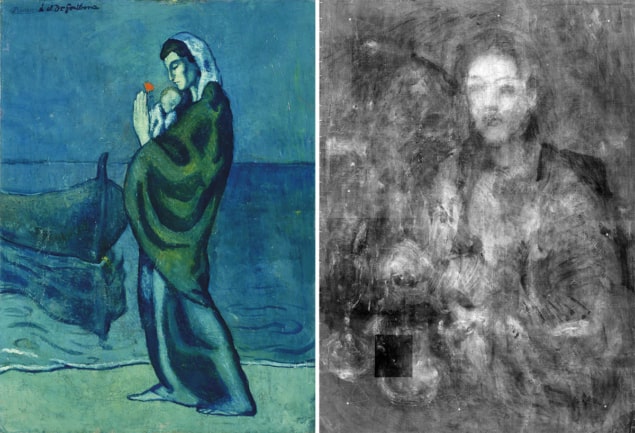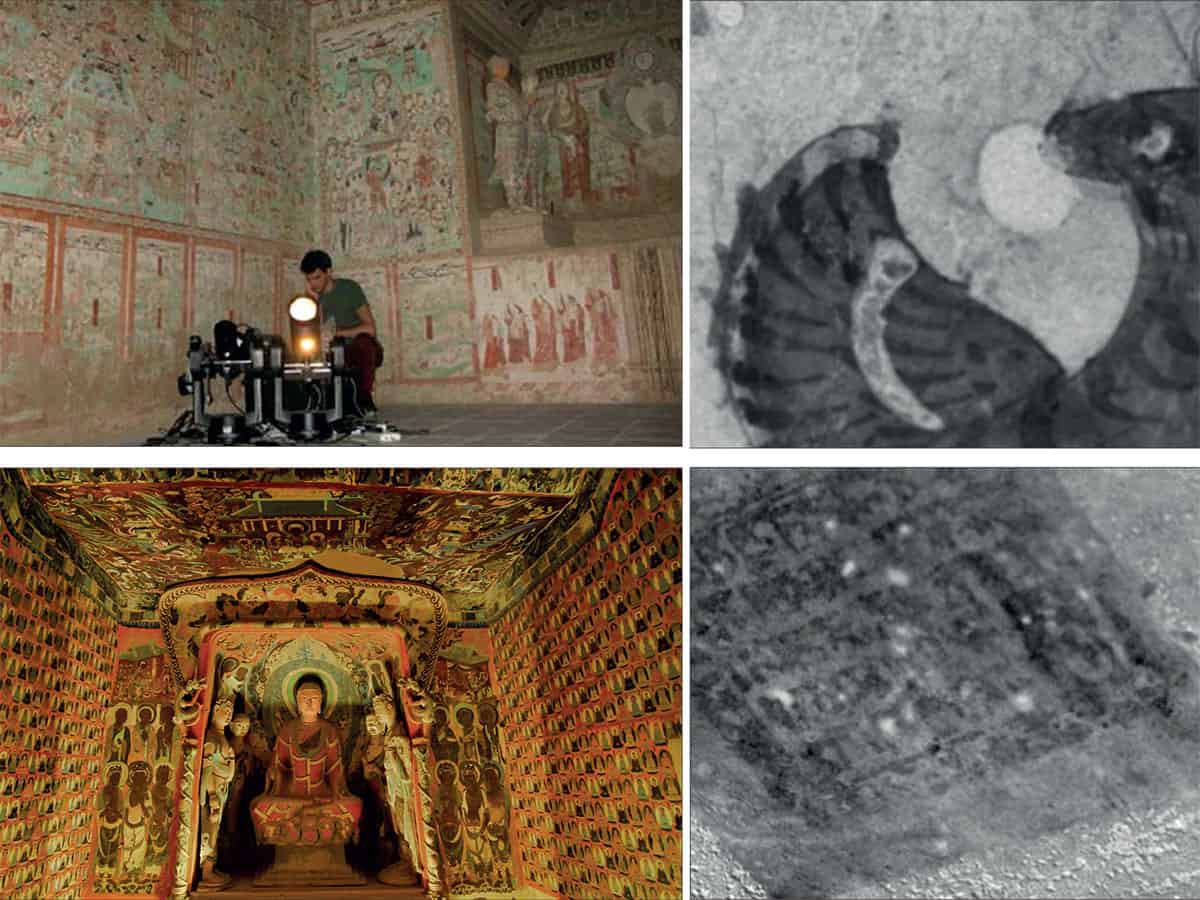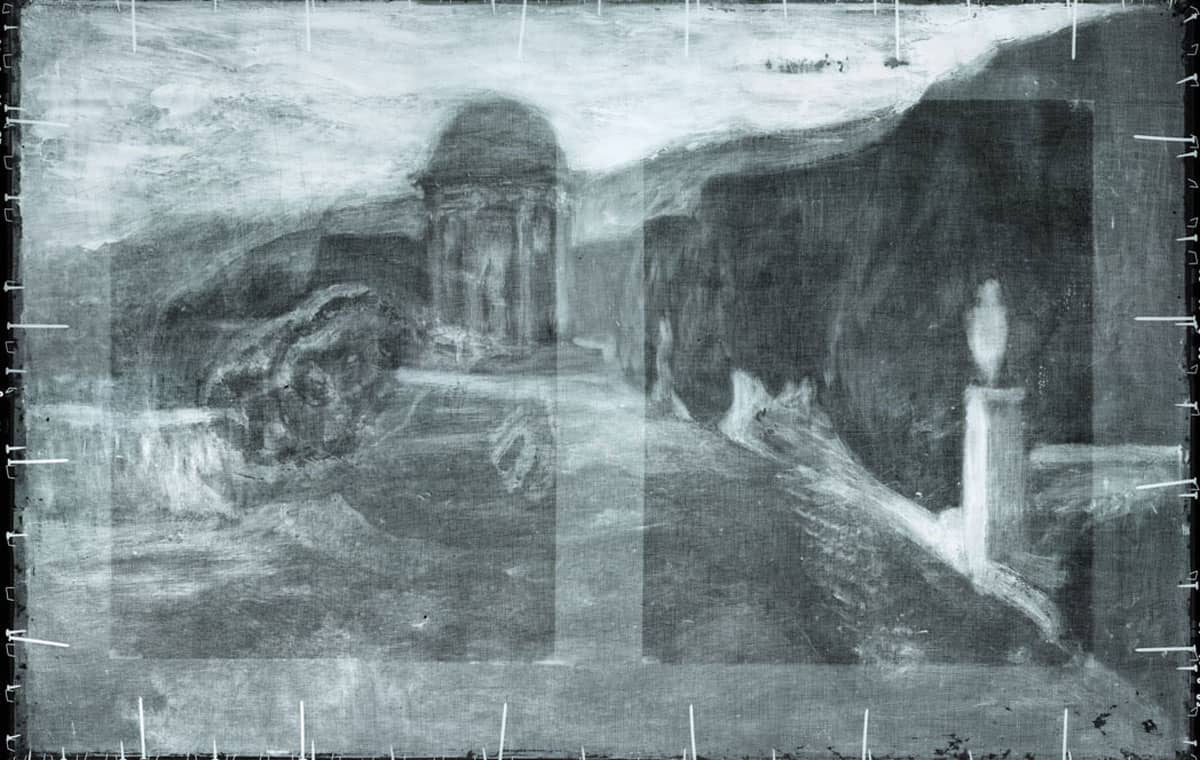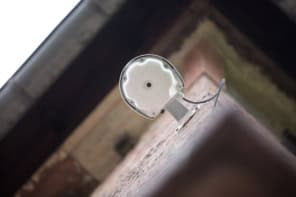Hidden beneath some masterpieces there are other paintings, visible only to state-of-the-art spectroscopic imaging techniques. Stephen Ornes looks at some of the secrets that hyperspectral imaging has uncovered

When Spanish artist Pablo Picasso painted Mother and Child by the Sea in 1902 (see below), he inadvertently launched a hi-tech game of hide-and-seek. The painting – completed during the artist’s “Blue Period” (1901–1904) – depicts a shrouded figure holding an infant on a beach, with a boat in the background. The work has not only attracted the attention of art enthusiasts, conservators and historians, but also scientists. Equipped with state-of-the-art spectroscopic techniques, researchers have been able to reveal details hiding mere microns beneath the surface.
Spectroscopic techniques – which study what happens when matter and radiation interact – have long been able to reveal the chemical composition of objects, ranging from distant stars to compounds in a lab. Now, scientists are training these methods on old works of art, uncovering new findings at the intersection of culture and science. Thanks to decades of advancements in the technology, it’s possible to observe the spectrum emitted by the paints, pigments, binders and other materials used to create the painting.
One physicist at the forefront of this field is John Delaney, who’s been the senior imaging scientist at the US’s National Gallery of Art in Washington, DC, for more than a decade. Having trained as an optical physicist, Delaney has developed near-infrared imaging techniques to analyse historical artefacts, ranging from ancient Egyptian paintings and 15th-century illuminated manuscripts to artwork from the Italian renaissance. He’s also analysed Picasso’s Mother and Child by the Sea.
From Cubism to cubes
One method Delaney specializes in is hyperspectral imaging, which combines digital imaging with spectroscopy. Like other forms of spectroscopy, the technique measures the wavelengths of radiation reflected by a material in order to identify it. The incident illumination that shines on the artwork may come from ambient light or an additional source of visible light. Experimental techniques may even analyse heat released by the pigments or paints. Importantly, hyperspectral imaging can differentiate between the illumination and the signal from the materials themselves.
For every pixel in an image, a hyperspectral camera collects the spectrum of electromagnetic radiation in hundreds – or even thousands – of narrow wavelength bands. As each band can be less than 10 nm wide, the spectrum appears to be continuous. Hyperspectral imaging can also look at the near-infrared region – Delaney’s camera, for example, can detect wavelengths in the visible and near-infrared range, from about 750 to 2500 nm. This is far superior to the human eye, which can see only visible light in the bands of the three primary colours.
“With hyperspectral imaging, what you’re seeing essentially are colours, but not in a qualitative way like in our brains,” says Koen Janssens at the University of Antwerp in Belgium, who has used scientific imaging tools to look at René Magritte’s Le Portrait and Vincent van Gogh’s Sunflowers among others (see box on p28). “Instead, you try to measure it in such a way that you can make more subtle distinctions between colours and hues.”
This type of analysis produces an image “cube” for each pixel – a 3D array showing which wavelengths of the spectrum are represented, and in what distribution. These can be connected to the known spectra of pigments, paints, binders and other materials used by an artist.
Hyperspectral imaging is also appealing for conservation and preservation because, unlike other methods of spectroscopy, it’s non-invasive, and findings can reveal surprising details about the history and culture in which the art was created. Furthermore, some paints and pigments become transparent to radiation at large wavelengths – like in the near-infrared region – which is why imaging spectroscopy can see things hidden to the human eye.

From canvases to caves
Hyperspectral imaging of art is not limited to canvas paintings in museums. Seven years ago Haida Liang of Nottingham Trent University in the UK took the technique to the Mogao Caves at the edge of the Gobi Desert, in central China. Also known as the Caves of a Thousand Buddhas, it’s an immense, UNESCO-protected site that includes nearly 500 cave temples, the walls and ceilings of which are covered with paintings from the 4th to the 14th century, including repeating painted Buddhas. Liang and her team have been studying the paintings using a range of proprietary tools.
Some of the cave ceilings, however, reach more than 10 m high. “Because of those lofty heights, they’re difficult to get to,” Liang points out. In the past, researchers had to climb up scaffolding or lift instruments to get a close look at paintings on or near the ceilings. But Liang saw a different way. “Astronomers don’t have to climb to the Moon to get a good look at the Moon,” she says. Instead, they use telescopes – so she would too.
Liang and her team used PRISMS (Portable Remote Imaging System for Multispectral Scanning) – a device that produces high-resolution spectral and 3D topographic images of large surfaces, like wall paintings (ISPRS J. Photogramm. Remote Sens. 95 13). The system combines the imaging abilities of telescopes, lenses, filters and CCD cameras. In the caves, the scientists set up gentle lights for illumination and put the PRISMS system on the ground, where it could collect data from a large field, like the ceiling or entire wall. In 2014 the group reported images with a resolution of 80 μm, taken from a distance of 10 m. In addition to showing which pigments were used, the imaging revealed previously unseen features, including faded Sanskrit writing on the ceiling and invisible drawings. Studies like this one can help researchers better determine when the caves were built and decorated.
Spectral synergy
While hyperspectral imaging is powerful, some researchers have found that it’s even more revealing when combined with other techniques, such as X-ray fluorescence and X-ray powder diffraction. Data collected using X-rays complement those gathered by hyperspectral imaging because they can penetrate deeper into a painting. Fusing data from multiple modalities can reveal new information lost to any individual one.
Delaney says that such technique combinations are the horizon for the field. He’s also investigating new ways to record spectrographic data from images. Most cameras use reflected light, but in his lab in Washington he and his collaborators are also developing techniques that look at thermal emissions from paintings in cool, pitch-dark chambers.
Back in her lab at Nottingham, Liang is developing a way to automatically process PRISMS data obtained from large surfaces – such as entire walls of caves, the outside of buildings, or even large amassed collections of paintings and manuscripts. Thanks to advances in machine learning and artificial intelligence, she says, processing such large datasets could be quick and efficient. She envisions online galleries where visitors can view the art and download its spectral data or view a chemical map of the pigments used.
Over in Antwerp, Janssens says researchers are finding ways to not only probe deeper into existing artworks – identifying pigments or hidden writing, say – but also distil valuable cultural and historical information from looking at the details at increasing depths. “If the artist is the constructor, then we do the inverse, and de-construct it,” he explains. “But in a virtual way, of course. With no damage.”
More secrets


Hyperspectral imaging data have not only been used to analyse Mother and Child by the Sea. John Delaney from the US National Gallery of Art has also used the technique to study another of Picasso’s Blue Period paintings – La Miséreuse accroupie (The Crouching Beggar). The analysis revealed that Picasso had first painted over a landscape scene by another artist and incorporated elements of the original canvas into the final product. The curve of a mountain, for example, became the curve of the beggar’s cloak. In addition, the study shows how Picasso changed his mind about composition, by covering the beggar’s bare arm with a cloak.
Meanwhile, working with Delaney and others, Koen Janssens at the University of Antwerp has studied Belgian artist René Magritte’s Le Portrait by combining hyperspectral imaging with X-ray fluorescence in 2016 (Applied Spectroscopy 70 57). The work revealed a hidden composition by the artist that would show up in his 1927 painting La pose enchantée.
Janssens and his collaborators later studied the painting Sunflowers by the 19th-century impressionist artist Vincent van Gogh, using X-ray powder diffraction, a chemical-mapping technique. Van Gogh used many different yellow pigments to execute the famous painting, but previous studies have noted that the yellow is darkening over time. In a 2018 paper, the scientists discovered that the culprit is one of the chrome yellow pigments, which loses its lustre when exposed to sunlight (Angewandte Chemie 57 7418).
Back to Picasso
That’s exactly what Delaney was able to do when he looked at Picasso’s Mother and Child by the Sea through his hyperspectral camera. He immediately made an unexpected finding: a jumble of printed letters in the face of the mother figure. Further investigation revealed that those letters ran backwards and were newsprint. Two of the words that could be seen clearly were “l’Automobile” and “président”.
This revelation was enough to lead Keiko Imai – chief curator at the Pola Museum of Art in Japan, where the painting is kept – to figure out that the newsprint came from the 18 January 1902 issue of Le Journal, a daily French newspaper. Exactly why the newsprint was there remains a mystery, but it suggests that Picasso – who was well known for recycling canvases and painting over existing works (both his own and other artists’) – had in fact covered the canvas with the paper before he created Mother and Child by the Sea.
As well as providing an insight into Picasso’s methods, the finding means the painting could be dated more accurately – it had to have been created some time after 18 January 1902. It also explained some unusual texture features of the paint itself, which would have emerged because the paint was on newsprint, not directly on canvas.
“The Blue Period Picassos are particularly fun,” says Delaney, who has previously looked at another piece from the period called La Miséreuse accroupie (The Crouching Beggar). The technology has advanced to a point, he explains, where images of the canvas that underlies a painting can be used by art historians to identify the original artwork on it (see box above).
In the case of Mother and Child by the Sea, hyperspectral imaging uncovered even more secrets. Details of the painting that Picasso had painted over became clearer, revealing a woman, seated, holding a glass of absinthe. Delaney and his colleagues also found an upside-down signature by Picasso – suggesting there may be another undiscovered image that has yet to be observed. Perhaps the next generation of imaging spectroscopy will reveal more.



